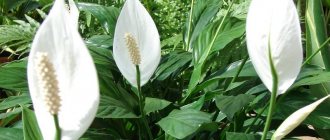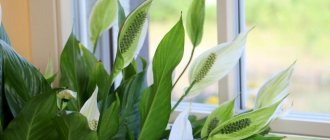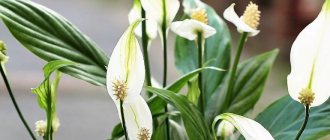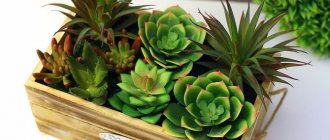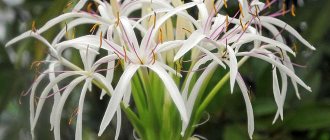Spathiphyllum (popularly known as “Women’s Happiness”) is a plant of the Araceae family.
This exotic flower takes root well in apartments and offices and is easy to care for. Dear readers!
For you, we have created communities on social networks in which useful articles and interesting ideas are published several times a day! Subscribe and receive useful content in a convenient format! The flower has large shiny leaves of rich green color and white inflorescences on a long stem.
In the wild it grows in the South American tropics and on the Philippine islands.
Caring for Women's Happiness after Purchase
For spathiphyllum to grow and bloom, it is necessary to create the right conditions and provide appropriate care. “Women's Happiness” loves lighted places or partial shade, room temperature and high humidity. It does not tolerate direct exposure to ultraviolet radiation and drafts.
Spathiphyllum feels best near eastern or western windows.
IMPORTANT! Having bought a flower in a store, it must be quarantined so that it gets used to its new microclimate. This will also protect other plants from possible infection by diseases and parasites.
Do I need to replant after purchase?
In the store, flowers are sold in small pots made of cheap thin plastic. This is done to save money. Moreover, sometimes instead of nutritious soil in stores, the flower grows in a special transport substrate. After watering, it thickens and stops allowing air to pass through to the roots. Because of this, they gradually begin to rot.
Thus, replanting a plant after purchasing and maintaining quarantine is necessary and is part of caring for women’s happiness.
First, you will inspect the root system of the flower. This will help identify diseases.
Secondly, spathiphyllum will grow in new nutrient soil. In this case, the soil will be loose enough so that the water does not stagnate in it and the roots do not rot.
Thirdly, you can choose the right size pot for the flower. This will further stimulate its growth.
Description of spathiphyllum
Spathiphyllum (lat. Spathiphyllum) is a perennial plant of the Araceae family. The name goes back to the Greek “spathe” - bedspread and “phyllon”, which means “leaf”. This is due to the shape of the flower, which looks like a regular leaf but is white in color.
The birthplace of spathiphyllum can be considered:
- South and Central America;
- East Asia;
- Polynesia.
Most species originate from the South American tropics.
Spathiphyllum stems . The leaves grow in a bunch, starting immediately at the ground. They have an oval shape. The vein in the center of the leaf is clearly expressed, the lateral veins are depressed. The root system is shallow.
The plant forms cob-shaped inflorescences on oblong stalks. At the base of the flower there is a large white petal, resembling a spoon, which turns green with the end of flowering .
Growing conditions and care features
Today, about five dozen varieties of spathiphyllum are known. About half is used for decorative purposes, and about 10 are suitable for home and office use.
Caring for spathiphyllum at home briefly:
- Lighting : bright, diffused. When located on the south side, shading is required.
- Temperature : +21+23 degrees Celsius.
- Humidity : high. Regular humidification from a spray bottle or an automatic humidifier is required.
- Location : ideally - eastern window sill. Place it on the south side in the back of the room.
- Feeding : 1-2 times a month. During the dormant period, do not feed.
- Watering : as the soil dries out. Do not allow water to stagnate in the pot.
- Transplant . The young plant is replanted annually. Then - once every 2-4 years.
- Reproduction : dividing the bush during transplantation or cuttings.
- Dormant period : October - February.
- Other : protect from drafts, select a pot according to size, regularly prune after flowering.
Spathiphyllum is unpretentious in care and growing conditions. It is able to grow even in a dark corner at low temperatures. Of course, in this case the plant gets sick more often and looks inconspicuous, with small leaves and pale flowers.
To achieve beautiful flowering of spathiphyllum, it needs to create the most comfortable home conditions.
Lighting at home
For proper care and growth, spathiphyllum must be provided with the necessary amount of light. But, at the same time, “Women’s Happiness” does not tolerate exposure to direct rays of the sun. Therefore, if you place a plant on the south side, it must be shaded.
Spathiphyllum can also develop in partial shade. But you should be careful here; poor lighting makes the leaves of the plant small. The inflorescences become pale and quickly fall off.
Temperature
Spathiphyllum loves warmth. The ideal temperature is about 23 degrees. Spathiphyllum is a hardy flower and can grow in both lower and higher temperatures. However, you should not subject the plant to tests, as the flower will begin to hurt.
Air humidity
Like a true resident of the tropics, spathiphyllum loves a humid climate. Therefore, if your apartment is dry, then you need to spray it with a spray bottle. During the summer months, it is advisable to do this in the morning and evening.
In addition, it is recommended to place a container with wet expanded clay or pebbles next to the pot.
You need to especially carefully monitor air humidity in winter and summer. During the cold season, heating devices operate to dry the air. In summer it is very hot, and moisture evaporates quickly in the sun.
Choosing a place to put the flower
Spathiphyllum must be protected from the harmful effects of the sun. If your windows face south, then it is best to place the plant in the back of the room. The best place for this exotic plant is near the eastern window. There the flower will have light, but it will not get sunburned.
What does a houseplant look like in the interior?
Spathiphyllum will add color to the interior of your room or office. At the same time, the flower does not look pretentious or vulgar.
The plant looks very beautiful on a light or, conversely, very dark background.
Some people prefer to place spathiphyllum in the bedroom at the head of the bed. Also popular is placement on low pedestals.
Tall varieties are placed directly on the floor.
You can also decorate the flower by placing containers with wet pebbles or decorative moss next to it.
Problems when growing spathiphyllum
“Women's Happiness” is a fairly unpretentious flower that does not require special care. It is enough for him to provide normal lighting, sufficient humidity and temperature. But in some cases a number of problems may arise.
The roots are rotting
The cause of rotting is most often high humidity. The plant is moisture-loving, but it should not be overwatered. Also, the roots rot as a result of the development of a disease or when attacked by pests. It is enough to remove the affected roots, wash the plant and replant it in another soil.
Pale leaves
Many varieties of spathiphyllum have bright green leaves. But if they turn pale, this indicates that the plant does not have enough light. It is enough to move it to a more illuminated place, but not under direct sunlight.
drooping foliage
If the leaves droop, this indicates insufficient watering. The plant should be well watered and sprayed.
Leaf blades rot
The causes of rotting are cold water or too frequent watering. The water must be settled, and its temperature must not be lower than 18 degrees.
All affected leaves should be cut off and washed with crushed activated carbon or a fungicidal agent.
Doesn't grow well
In the case where the plant grows slowly and does not bloom, this indicates a large pot. Spathiphyllum loves cramped spaces, so the container needs to be selected accordingly.
Poor growth can also be caused by an underdeveloped root system. He needs to be fed.
Spots on leaves
When spots appear on the leaves, this indicates a violation of sap exchange. The plant needs to be provided with moderate watering. The problem can also arise as a result of the development of a viral or fungal infection.
The leaves are curling
If the leaves on a flower begin to curl, this may indicate a lack of potassium and magnesium in the soil. The plant needs to be fertilized.
Cold weather can also cause leaves to curl. The pot needs to be moved to another place.
Dries
When the spathiphyllum leaves dry, it needs to be watered. This occurs when there is insufficient humidity. It is recommended to spray the plant regularly.
Drooping
The reasons why “female happiness” has wilted may be improper watering, excessive amounts of fertilizer, or sudden temperature changes. Drooping leaves also serve as a signal that pests, such as aphids, have infested.
Spathiphyllum leaves droop even after transplantation. Once the plant recovers, the leaves will return to their normal position.
Turns yellow
Yellowing leaves of “female happiness” appear for several reasons:
- pests or disease;
- lack of nutrients;
- incorrect watering regime;
- exposure to cold;
- dry indoor air;
- exposure of leaves to ultraviolet rays.
The cause must be found out and eliminated immediately, otherwise the plant will die.
Flowers turn yellow
Spathiphyllum flowers begin to turn yellow as a result of insect activity or due to the development of diseases. Also, the reasons are improper care, when the plant was kept at an inappropriate temperature, or the pot is in a draft. Flowers may also turn yellow as a result of a lack of essential microelements in the soil. It needs to be fertilized.
Leaves turn black
Blackening of the leaves occurs against the background of freezing of the roots when watering was carried out with cold water. This also occurs as a result of insufficient soil or air moisture.
The appearance of black spots on the leaves also indicates that the plant has received sunburn, has been overfed with fertilizers, or the soil has been improperly selected.
The edges of the leaves turn yellow
The edge of the leaf turns black for several reasons: lack of nutrients and vitamins, exposure to sunlight, improper watering or dry soil.
The edges of the leaf may also turn black as a result of poor-quality soil, damaged roots, an excessively small pot, or low room temperature.
Doesn't bloom
In the case when spathiphyllum does not bloom for a long time, experienced gardeners recommend:
- Change lighting. Perhaps the plant is not getting enough light. You need to hang a special phytolamp on the windowsill with the pot.
- Change the watering mode. Perhaps the lack of flowering indicates improper watering. The soil should be moistened immediately after the top layer of soil in the pot dries out.
- Remove from drafts. Spathiphyllum does not like cold air, so it should be placed where there are no drafts.
Another reason for the lack of flowers may be a lack or excess of fertilizers. The fertilizing regime needs to be reconsidered.
Droplets on the leaves
Many novice gardeners are concerned that droplets begin to appear at the tips of the leaves of “female happiness”.
This is quite normal. This way the plant gets rid of excess moisture. There is also a belief that the plant “cries” before the rain. But this is just a superstition.
Popular varieties of “Women’s happiness”
Chopin
Spathiphyllum Chopin
This plant variety is the result of selection. Chopin has a small height (about 35-40 cm) and is easy to care for. It has elongated leaf blades with clearly visible veins. The aroma is pleasant, but not cloying.
Vivaldi
Spathiphyllum Vivaldi
This variety is distinguished by a cream-colored inflorescence located on a high stalk. The leaves, unlike the Chopin variety, are more oval. The central vein is clearly visible. The rhizome is shortened.
Sensation
Spathiphyllum Sensation
Hybrid is distinguished by its high growth. With proper care, spathiphyllum “Sensation” can grow up to 150 cm. It has proportionate, large and expressive inflorescences.
Wallis
Spathiphyllum Wallis
This variety is considered the founder of many other varieties of spathiphyllum. It is not too tall, about 30-45 cm. The size of the inflorescence is about 3-5 cm. Among all varieties, it is considered the hardiest and most suitable for growing at home, one of the most unpretentious varieties to care for.
Cannofolia
Cannoleaf spathiphyllum
This variety is often used for breeding and is rarely found at home. The inflorescence is yellowish, the leaf blades are rich in color.
Verdi
Spathiphyllum Verdi
Variety Verdi grows up to 70 – 75 cm in height. It is distinguished by its snow-white inflorescence. Among all varieties of spathiphyllum, it requires special care conditions and is the most light- and heat-loving. The optimal temperature for growing is 25 - 27 degrees.
Domino
Spathiphyllum Domino
This hybrid blooms longer than others, with proper care. It also looks more advantageous thanks to the neat leaves, pointed at the end. It differs in appearance due to the randomly located stripes on the leaf plates. This feature gave the variety its name.
Picasso
Spathiphyllum Picasso
This variety is similar in appearance to "Domino", but the white stripes on its leaves are more often located. Moreover, some leaf blades are colorless. It is the result of breeding work with the “Wallis” variety.
Types of home spathiphyllum with photos and names
In indoor cultivation, the most popular are several types of spathiphyllum out of 50 known in nature:
Spathiphyllum Abundantly blooming (S. floribundum)
A plant with a dense rosette, sometimes consisting of 40 leaves, glossy and dark emerald, 20-25 cm long. It can bloom all year round, the inflorescence is white and yellow.
Spathiphyllum cannifolium (S. cannifolium)
The foliage of this species resembles canna leaf blades and reaches half a meter in height. The cob is light-yellow in color and covered with a delicate white-greenish blanket. With good care, it blooms twice a year: in April-June and at the end of November.
Spathiphyllum Adorable (S. blandum)
It is distinguished by a pale green spathe covering an ear of the same shade, surrounded by large foliage up to 20-35 cm long on petioles reaching 30-40 cm.
Spathiphyllum spoon-shaped (S. cochlearispathum)
A tall species, capable of stretching up to a meter mark. The leaves are large, about 35-40 cm, on petioles 70 cm high. A characteristic feature of the inflorescence is yellowish at the beginning of flowering, and by the end it almost turns black. The blanket is white and has a concave shape similar to a sail.
Spathiphyllum Wallis (S. wallisii)
Perennial from 30 to 60 cm in height with shiny foliage up to 25 cm long. The edges of the leaf blades are wavy. Flowering begins in late spring or early summer, and again in autumn or winter. The cob is light yellow, wrapped in a snow-white blanket, three times larger than the cob.
The best varieties:
Chopin is a compact variety no more than 30-35 cm in height with fragrant flowers with an elongated veil with a pointed tip;
Sensation - considered the largest variety for indoor cultivation, reaching 150 cm in height, with foliage almost 80 cm long;
Picasso - a variegated variety with a white-green pattern on the leaves;
Cupido is a Dutch hybrid with an unusual bedspread shape - elongated and tapered towards the top, colored in various shades of green.
Spathiphyllum is very popular in indoor floriculture due to its unpretentiousness and easy care, accessible even to beginners who are learning the basics of handling plants.
Conditions for flowering, or how to care for it to bloom
The flowering of spathiphyllum depends on the care conditions that are provided to it.
- Correct pot size. If the container is too small, the flower will have nowhere to grow. If it is too large, then the spathiphyllum will not bloom until its roots fill the entire volume.
- No drafts. From drafts, spathiphyllum gets sick and sheds its leaves. Therefore, if you open the windows for ventilation in winter, the plant must be moved to another place at this time.
- Correct temperature conditions. Women's happiness grows well at room temperature. If the thermometer shows less than 16 degrees for a long time, the flower will get sick and die. If, on the contrary, you place it in the scorching sun, the plant will simply “burn out.”
- Lack of nutrition. Spathiphyllum is fed 1-2 times a month. During the dormant period, it is better to stop feeding.
- Timely watering. Women's happiness should be watered as the soil dries out. Under no circumstances should water be allowed to stagnate in the pot. Because of this, the root system of the flower rots.
- Prevention of diseases and pests. Regular inspection of the flower will help prevent the development of fungal diseases and pests. If you do not want your spathiphyllum to disappear, carefully inspect the stems and leaves of the flower at least once every two weeks.
Conditions for keeping spathiphyllum at home
In order for a flower to please with abundant and long-lasting flowering and gorgeous foliage, it is necessary to observe special conditions for its maintenance. It’s not difficult at all, the main thing is to take into account all the tips and recommendations and choose the most suitable place.
Temperature
In summer, a temperature of 20 to 27 degrees is suitable for him. This way the plant grows well and receives the necessary amount of heat. When the temperature in the room is above 30 degrees, it is not worth keeping the flower there for a long time.
In winter, spathiphyllum tolerates temperatures of 16 degrees. But it is not advisable to keep it on a windowsill where it is drafty. The plant is afraid of drafts.
Humidity indicators
In the wild, spathiphyllum grows in tropical rainforests and in areas near swamps. Therefore, it is important for the plant to provide a normal level of humidity. With a lack of water, flowering will be poor and the leaves will dry out.
“Women's happiness” loves to be sprayed. It is important to ensure that drops of water do not fall on the flower itself. But it is important not to overdo it, as constant humidity will lead to rotting of the roots.
Lighting
Spathiphyllum is afraid of direct sunlight. At the same time he loves light. The thing is that ultraviolet light burns the leaves.
Many varieties are able to grow normally in a shaded place. But insufficient light will cause the color of the leaves to become dull, and the leaf itself will stretch and change its shape.
Where to keep
Spathiphyllum will grow well in almost any corner of the house. But it should not be placed on a windowsill where there are drafts. Then the plant will constantly get sick, grow poorly and may die.
The ideal place for “female happiness” would be a well-lit area of the apartment. In winter, a window facing south is suitable, and in summer – facing north. Important to remember. That spathiphyllum does not tolerate sudden climate changes, so its location should be changed as rarely as possible.
Flower transplant
There is no need to replant Women's Happiness too often. While the flower is still young and growing, this can be done once a year. When the plant reaches its maturity, the frequency of transplants is reduced to once every 2-4 years.
Most often, spathiphyllum is transplanted using the transshipment method so as not to damage the roots.
But, if your pet is sick or has been in the same soil for too long, then when replanting it is better to clean the roots from the old soil. This method will also allow you to propagate spathiphyllum.
IMPORTANT! When replanting Women's Happiness, be sure to place drainage at the bottom of the pot.
Spathiphyllum transplant
Transfer
Spathiphyllum blooms only when the pot is somewhat cramped. In a large pot, all his energy goes into developing the root system. When it fills almost the entire volume, flower stalks are thrown out. The young plant needs annual replanting. In this case, each time the diameter of the pot should be 2-3 cm larger.
In an adult spathiphyllum, the number of transplants is reduced to one every 3 years. The time of the procedure is spring, after the end of the dormant period and before the start of flowering.
Spathiphyllum transplant
Step by step steps:
- Water the plant a little and carefully remove it from the previous pot;
- Clean the roots with light movements. Rotten and very long - cut off;
- Move the spathiphyllum into a new pot with a drainage layer and a small amount of soil, sprinkle the substrate on top and press lightly so that the flower sits tightly;
- In the first days after transplantation, moderate watering and frequent spraying are recommended. Then normal care is resumed.
Landing
When planting spathiphyllum, it is very important to choose the right pot size and soil. Women's happiness grows best in a mixture of peat, sand, turf, leaf soil and humus.
Before placing a flower in a new container, it is imperative to inspect the root system. Rotten and damaged roots are removed. Cuts and wounds are treated with a solution of potassium permanganate and sprinkled with crushed activated carbon.
Also, when planting spathiphyllum, it is recommended to trim off old leaves and peduncles. This is done so that the plant takes root better.
Spathiphyllum in the interior
“Women's Happiness” will perfectly complement any interior thanks to its large bright green leaves and unusual flowers.
Varieties that grow up to 1 meter can be planted in special outdoor pots. Small views will decorate any windowsill or any other place. Spathiphyllum is often placed in bedrooms. Many believe that the plant will protect against adultery and ignite passion between spouses.
Reproduction
You can get several new young plants from one spathiphyllum in 3 ways:
- Seeds.
- By dividing the bush during transplantation.
- By cuttings.
The most effective way to propagate this plant is by dividing the bush. When you transplant a flower to a new place, you need to thin out the shoots. This can be done by dividing the rhizome into several parts. This way you will get 2-3 new plants that can be planted in separate pots.
The advantage of this method is that you get ready-made plants with a developed root system.
Reproduction of spathiphyllum
IMPORTANT! When dividing a spathiphyllum bush, be very careful. Be sure to treat damaged roots with potassium permanganate and crushed activated carbon.
Reproduction of spathiphyllum
Spathiphyllum is usually propagated in the spring, during a planned transplant. This way the plant will be less stressed, and the new shoots will have time to get stronger before winter.
By dividing the rhizome
Propagation by dividing the rhizome is the most common method. To do this, carefully remove the flower from the pot and carry out a careful inspection. It is divided in such a way that on each new fragment a growth point remains, as well as 2-4 leaves. This is the place near the rhizome where a new leaf begins to unfurl.
The mother plant is planted in the same pot where it grew, and fresh soil is added.
New bushes are planted in pre-prepared pots with moist soil. For the rooting process to be successful, it is better to cover them with a plastic bag to create a greenhouse effect.
Seeds
The plant can be propagated through seeds. But this method has a significant drawback: the new flower does not always retain the characteristic features of the mother one. This applies most of all to those varieties that were bred by crossing.
Among other things, the seeds are not stored for a long time. If you are late with sowing, their germination rate will be very low. Spathiphyllum, grown from a seed, grows and develops slowly. It may not bloom for a long time.
Trimming
Spathiphyllum is pruned after flowering has ended. The old peduncle is removed, as well as yellowed or dried leaves of the plant. This procedure is carried out so that nutrients are not consumed on the faded peduncle.
Trimming is carried out with a stationery knife. This way the cut will be neat. By pruning with scissors, you damage the plant tissue, which can lead to infection. Sections must be treated with crushed activated carbon.
Pruning should be done as close to the root as possible.
Hoya
Hoya is a vine with fleshy, waxy leaves. It is also called wax ivy. The plant is not capricious; during flowering it has a pleasant aroma. The liana is grown in hanging pots, but other methods are also used.
People who believe in omens call her a “husband.” It is said that khoya can make a wife a widow and also wards off men. Brings misfortune and quarrels to the family.
This plant is suitable for office space, but not for a comfortable emotional atmosphere in the house.
Rejuvenation
Rejuvenation is important in the process of growing spathiphyllum. The fact is that over time the plant ages and loses its beauty.
The most effective way to rejuvenate a flower is to root a stem with aerial roots. The algorithm of actions is as follows:
- Select a stem with aerial roots.
- Cut the petioles from the stem so as not to damage the aerial roots. Please note that you need to cut off the petioles that are located below the leaf.
- Wrap the stem below the leaf rosette with a plastic sleeve.
- Make several ventilation holes in the sleeve.
- Moisturize periodically.
- After 50-60 days, roots will appear under the film.
- Cut the stem below the sleeve.
- Carefully remove the film so as not to damage the roots and plant the plant in the pot.
There is an easier way - cut off part of the stem with a rosette and place it in water until roots appear. When the roots grow to about 5 cm, the plant can be planted in a permanent place.
Bush pruning and rejuvenation
Caring for spathiphyllum at home includes trimming leaves and flower stalks and periodically rejuvenating the bush. This must be done correctly, otherwise the plant may die from illiterate actions.
It is impossible to remove old leaves that have lost their decorative effect during flowering. The operation is carried out only after a woman’s happiness has completely faded or before the buds are thrown out. The best period for the procedure is considered to be early spring.
Trimming old flower stalks is necessary so that the plant does not waste additional energy and nutrients. This will stimulate the formation of new buds faster.
Pruning is done above the place where the peduncle emerges, trying not to damage other vegetative organs of the flower.
Spathiphyllum needs rejuvenation as the bush ages. To do this, take the flower out of the pot, take it apart, clean off dry or rotten fragments of the rhizome, and cut off the dry leaves. Disassembled healthy daughter rosettes are planted in the ground.
The plants remaining without roots after the procedure can be placed in water for further propagation.
Watering
The watering regime for spathiphyllum depends on the time of year. In spring and summer, during the period of growth and abundant flowering, watering should be regular and abundant. In autumn and winter – moderate.
IMPORTANT! At any time of the year, you need to water the plant only when at least the top layer of soil has dried out. Otherwise, the water will begin to stagnate. This will lead to rotting of the root system.
Spathiphyllum should be watered with settled water at room temperature. Ideally, filtration can also be carried out to remove harmful deposits.
Diseases
Improper care can lead to the development of a number of diseases:
- Root rot. The reasons are too much watering or insufficiently loose soil. You can get rid of it by removing the affected roots and treating the remaining ones with Glyocladin. It is recommended to transplant the flower into more suitable soil and water it properly.
- Gommoz. These are bacterial infections that cause the leaves to wilt. Affected leaves should be removed and the plant should be washed with laundry soap.
- Phytosporosis. Fungal infection, in which the root system becomes soft and dies. Occurs when there is excessive watering or contaminated soil. Spathiphyllum needs to be transplanted into dry soil and watered as the top layer dries out.
To prevent the development of diseases, it is necessary to properly care for the flower and provide it with good conditions.
Planting gloxinia tubers: 5 useful tips to avoid making mistakes at the initial stage
Top dressing
Feeding Women's happiness is worth it in accordance with the time of year. During the cold season, apply fertilizers no more than once a month, and it is best to refrain from fertilizing at all.
In spring and summer, the amount of fertilizing increases, since more nutrients are consumed during the growth period. Therefore, at this time of year you need to feed the flower once every 2 weeks. This fertilizer application schedule continues until the end of flowering.
Spathiphyllum prefers organic fertilizers, but it perfectly accepts complex mineral fertilizers for flowers in diluted form.
Cissus
Diamond-shaped and arctic cissus species are often found on window sills. This perennial vine is sought after by indoor plant lovers for its showy leaves.
Such a houseplant should not be kept in the house by girls who want to get married. Cissus is considered a muzhegon.
Solitary leaves are the reason that they attract loneliness. Cissus also has an adverse effect on meeting young people; it is better to refrain from growing this vine in the house.
Diseases and pests
Spathiphyllum most often suffers from root rot, sooty fungus and late blight. All these are fungal diseases. They are dangerous because they spread very quickly throughout the plant and lead to its death.
If you notice that the leaves or stems of your pet have begun to turn black, then it is necessary to urgently treat it with a fungicide. In addition, the affected parts of the plant must be cut off and destroyed.
Spathiphyllum falls victim to the following pests:
- aphid;
- spider mite;
- scale insect;
- mealybug.
You can fight insects using insecticidal agents (for example, Fitoverma). You can also use tobacco infusion against aphids and scale insects. It is mixed with a soap solution and the stems and leaves of the plant are thoroughly treated.
To protect the flower from fungal diseases and pests, prevention should be included in the care of spathiphyllum. Preventive actions include: regular inspection of the plant, compliance with care rules, timely treatment with fungicides and insecticides.
It is important to remember that prevention is much easier than fighting for the life of an infected plant.
Sick spathiphyllum
IMPORTANT! If a flower is sick, it must be quarantined. In addition, it is necessary to conduct a preventive inspection of other plants.
Plant species
The most common types of spathiphyllum used in breeding are:
- spathiphyllum profusely flowering;
- Spathiphyllum Wallis.
Spathiphyllum Wallis is easiest to keep in an apartment. It is small and compact: small leaves do not reach 40 centimeters in height. This makes it an ideal flower for small spaces.
For larger rooms, a profusely flowering species is suitable. Its flower stalks grow up to 25 centimeters in length versus 9-12 centimeters for Spathiphyllum Wallis.
Healthy! Spathiphyllum is an excellent air purifier. It absorbs phenol, which is released by furniture, as well as benzene compounds. In a room where 4-5 spathiphyllum bushes grow, the air is saturated with ozone and oxygen. You get the impression that you are in the mountains.
How to resuscitate?
If your pet is not blooming, then there is a way to help him. But two conditions must be met:
- The flower should not be sick.
- The plant has not been recently replanted.
To make spathiphyllum bloom, it can be “shocked,” that is, placed in extreme conditions for a while. In an effort to survive, the plant will produce a flower.
To begin with, the pot with Women's Happiness is placed for 15 days in a cool place with a temperature of about 12 degrees.
After 2 weeks, the flower is returned to its usual place and a special liquid supplement (Uniflor-bud or Kemira Lux) or an extract from bird droppings is added.
IMPORTANT! Before purchasing fertilizer, make sure that the percentage of nitrogen in the fertilizer is less than the percentage of phosphorus and potassium.
After some time, the plant “shocked” in this way will begin to bloom. At this time, it is very important to maintain the required level of humidity in the room. Spray water regularly from a spray bottle or place containers of water near the plant.
Pests
“Women’s happiness,” like any plant, is susceptible to pests. They destroy leaves, flowers and roots. If you don't fight them, the flower will die.
Spathiphyllum most often suffers from aphids. It affects the reverse side of the leaf. It looks like a cluster of small green bugs. You can get rid of parasites with the help of Phytofarm. Spray the plant with the product according to the instructions on the package. If the affected area is small, it is enough to wash off the aphids with a warm shower. In order to prevent damage, it is important to monitor the level of humidity in the room.
Spathiphyllum is also susceptible to the spread of spider mites. The insect is very small in size. Its presence can be determined by the presence of a light white cobweb. The tick feeds on the sap of the plant. You can get rid of it using products such as Actellik or Aktara. In order to prevent the appearance of ticks, you need to monitor the level of humidity in the room.
What signs and superstitions are there?
Spathiphyllum is popularly called Women's happiness. There is a belief that a girl who plants a flower in her house will quickly find a betrothed and get married.
In general, a large number of legends, superstitions and signs are associated with this flower.
For example, it is believed that spathiphyllum should only be bought on Wednesday, Friday or Saturday from a saleswoman with blond hair. At the same time, they give you a little more money and under no circumstances take change.
Another sign is associated with the flowering of the plant. If several flowers appear on the peduncle at the same time, then good luck awaits the family. If spathiphyllum does not bloom for a long time, then expect trouble.
It is also believed that spathiphyllum growing in the house has a positive effect on the health of a pregnant woman.
You can read more about the magical properties attributed to this flower in our article “Attracting “Women’s Happiness” with Spathiphyllum, all the signs and superstitions associated with the flower.”
Ivy
Women love ivy for its ease of care. This is a climbing plant that is used to decorate the landscape or grow at home in hanging pots. However, since ancient times there have been some beliefs about it.
Climbing ivy in the house repels the opposite sex and interferes with marriage. It will be difficult for a girl to meet a young man if ivy entwines the walls and windows. The plant prevents the creation of a family.
The loach is considered an energy vampire. The more magnificent the ivy that is in the house, the faster the marriage will fall apart. Married women are better off not having one; it will drive the man out of the house.
Despite this, ivy is perfect for an office, flower bed or hedge. Outside the home, he will show only positive energetic properties.
Common mistakes
Spathiphyllum is a tropical plant, and beginners in floriculture often make a number of mistakes when caring for and growing it.
- The biggest mistake is placing a flower in the sun . Women's happiness loves sunlight, but direct rays overheat the leaf plates. The plant begins to hurt. Therefore, in summer the flower is shaded.
- The second most common mistake is improper watering . You only need to pour water into a flower pot when the top layer of soil has dried out. In winter you need to water even less often. Therefore, before watering the flower, test the soil with your finger; if it is wet, then watering should be postponed.
- The third common mistake is an incorrectly selected pot when replanting . The new container should be only slightly larger than the previous one. The fact is that first of all, any plant tries to fill the space with roots and only then begins to develop the above-ground part. Therefore, if you plant Women’s Happiness in a container that is too large, you will wait a very long time for flowering.
- Untimely transplant . Like any indoor plant, spathiphyllum needs to be regularly replanted into a new pot. If this is not done, the flower stops growing.
- The temperature regime is not maintained . Women's happiness grows best at moderate temperatures and high humidity. The flower can develop for some time at low temperatures (about 16-18 degrees), but at the same time it becomes weaker and more susceptible to various diseases.
- Prevention of diseases and pests is not carried out . Inspecting the plant after watering will only take a few minutes, but will help you notice the sore in time. And the sooner you see that something is wrong with the flower, the greater the chance that it can be saved.
- Lack of fertilizing during flowering . Flowering is a very energy-intensive process that depletes the plant. Regular feeding will keep the flower healthy at home and prolong flowering.
Transplanting the flower of female happiness (spathiphyllum) at home
Spathiphyllum loves close quarters. It is even believed that the tighter the roots are in the pot, the more abundantly it blooms. But if you see that the roots have begun to crawl out of the pot, there are too many rosettes, and the leaves are simply crowded, then it’s time to replant.
It is best to replant the flower in the spring. If the plant is replanted as a whole, the pot should be 2 cm larger in diameter. If it is divided, then the size should be proportionate to the divisions - you should not plant them in containers that are too large, you can flood the plant.
After transplanting the flower, it is better not to water it for 5 - 6 days, wait until the soil dries completely. But you need to spray twice a day, not allowing the leaves to dry out.
Answers to popular questions, or small secrets of success
Although spathiphyllum does not require extensive knowledge of floristry and is very easy to care for, many novice gardeners have a number of questions when growing this plant.
Why doesn't it grow well?
If the flower looks healthy, its leaves and stems are green without black, yellow or brown spots, then the reason for the poor growth of spathiphyllum is an excess of sunlight and moisture in the soil.
Another reason is the pot is too big. Until the root system develops properly, the green part of the flower will not grow.
If you accidentally “flooded” the spathiphyllum, then try loosening the soil. This will provide air access to the roots and allow the soil to dry out faster. If the soil remains wet for several days, then Women's Happiness will have to be transplanted into new soil.
Why does it wither?
There are several main reasons why spathiphyllum withers at home.
- A recent transplant is always stressful for the plant. It will take some time to get used to the new conditions. It is possible that some leaves will look wilted.
- Incorrect watering schedule . Wilting can also be caused by over- or under-watering. It’s much worse if you “flood” the flower. He will endure a mild drought and within a few days he will look healthy again. Excess moisture is dangerous because the earth clumps, air flow stops, and the roots begin to rot.
- Change of place. Women's happiness really doesn't like being moved from place to place. Changes in microclimate negatively affect primarily the leaf blades and peduncles, which begin to fade. Without a good reason, you should not rearrange the flower pot for a long time.
- Incorrect feeding regime. Beginning flower growers very often think that the more fertilizer they add, the more abundant the spathiphyllum will bloom. But this is a common mistake when caring for spathiphyllum. Excess minerals have a negative effect on the plant. In particular, processes of withering are observed.
- Pests. If you are sure that you have properly cared for your pet, pick up the leaves of the flower. Most likely, insects are breeding underneath them. They are removed from the leaf blades, and the bush itself is treated with insecticides and soap solution.
How often does it bloom?
Women's happiness blooms once per season. Most often - from March to the end of August - beginning of September. From October to February the flower should be at rest. To do this, it is pruned, watering and fertilizing are reduced.
You should not artificially achieve year-round flowering of spathiphyllum. The dormant period is very important for caring for the plant if you want it to delight you with lush flowers and live longer than a few years.
Constant flowering at home will quickly deplete a woman's happiness. It will become more vulnerable to fungal and bacterial diseases.
How to care for leaves
Spraying the flower
In spring and summer, spathiphyllum leaves are sprayed with a spray bottle and wiped with a damp cloth. This is done to increase the overall humidity, which this flower loves so much.
In autumn and winter, you should not spray the leaves with water, since the plant is dormant at this time of year. Just wipe the sheet plates with a dust cloth from time to time.
After Women's Happiness has faded, remove old, yellowed, wilted and dried leaves. This can be done while pruning the plant.
Why do the ends turn black?
If your spathiphyllum has blackened tips, it means you have overwatered the plant or applied too much fertilizer.
In this case, you need to stop watering and fertilizing for a while. The soil is loosened and dried. In the future, reduce the amount of fertilizer applied.
Why do flowers turn black?
The most common cause of blackening of the flowers of Women's Happiness is “wet hypothermia.” That is, when the plant is watered in the evening and remains standing on the window with the window open. The water does not have time to be completely absorbed, the temperature drops at night, and the roots of the plant become supercooled.
Saving women's happiness in this case can be very difficult. The plant will have to be moved to a warmer place, and the roots will have to be treated with Kornevin.
Also, blackening of flowers can signal a fungal disease. In this case, the plant is immediately quarantined and treated with fungicides with a thorough examination of the stems, leaves and roots.
Sometimes blackened flowers are the result of improper care. For example, non-compliance with watering and fertilizing regimes, too low a temperature, dry air.
How to increase the number of buds?
There are several tricks to increase the number of buds on spathiphyllum.
Firstly, there should be no old inflorescences on the plant. Therefore they will be deleted.
Secondly, the container with the flower is placed in a cold place for 15 days, and then returned back.
Thirdly, within a month it is fertilized twice with mineral fertilizers.
Fourthly, as soon as flowering begins, spathiphyllum is sprayed daily with warm water from a spray bottle. Be sure to do this carefully so as not to get on the buds.
Flowers to attract female happiness with photos
Since ancient times, magical properties have been attributed to plant crops. And not in vain - certain varieties are really capable of positively influencing women’s happiness. Below we describe the most popular varieties that bring happiness in your personal life.
Aichrizon
This crop does not exceed 30 cm in height. Aichrizon is a shrub plant that more closely resembles a miniature tree. A characteristic feature of the plant is its fleshy leaves with pubescence. During the flowering period, the aichrizon is covered with bright yellow flowers, which many compare to the sun. In rare cases, the petals of aichrizon are red.
Caring for a flower is not at all difficult, the main thing is to follow the watering regime and regularly spray the bush. He is very moisture-loving.
People call this tree the “tree of love.” Aichrizon is presented as a gift to newlyweds, wishing long and strong love. The plant helps unmarried girls meet their betrothed. Those who are married and experiencing some difficulties in relationships are also recommended to place this bush on the windowsill. It will help resolve conflicts.
Aichrizon is a shrub plant
Aloe arborescens
Aloe vera is considered a symbol of Venus. The plant has the ability to relieve a woman of loneliness and makes her attractive in the eyes of men. In addition, agave, as aloe is popularly called, is widely used in folk medicine. It is used to treat wounds, joint diseases, and skin diseases. The culture also protects against the evil eye and damage.
Caring for agave is very simple. Since aloe has fleshy leaves in which water accumulates, the crop needs to be watered rarely.
Anthurium
Anthurium is popularly called “male happiness.” For unmarried men, the flower brings success with women, and for married men it helps strengthen marriage bonds. Anthurium flowers are shaped like a heart. They are usually colored red, white, pink. For the plant to be as effective as possible, it is recommended to receive it as a gift.
Caring for anthurium is not an easy task. It is important for a tropical flower to provide conditions close to natural: high humidity, warmth, and absence of drafts.
Balsam
This crop comes from the tropics. Impatiens blooms all year round, and the color of the flowers often varies. Balsam is popularly called “family joy,” which is associated with the plant’s positive influence on family relationships.
When caring for balsam, the main condition is proper watering. The bush tolerates stagnation of water very painfully, even to the point of death. It is also not recommended to disturb the root system of balsam - it is very fragile and does not tolerate transplantation.
Balsam
Anthurium
Aloe arborescens
Wax ivy or hoya
This flower is considered a symbol of tenderness, love and fidelity. He patronizes his lovers, remaining faithful in relationships. A characteristic feature of wax ivy is its fleshy, heart-shaped leaves. Hoya is unpretentious in care. The main thing is to follow the watering regime, provide the ivy with diffused light and spray regularly.
Hoya is a symbol of tenderness, love and fidelity
Geranium, or pelargonium
Geranium is considered a talisman of the hearth. The plant has the ability to protect family members from quarrels, misunderstandings and mutual insults. In addition, pelargonium attracts wealth into the home.
Geranium has a rather pronounced aroma, so it is not recommended to place a flower pot in the bedroom.
Author's advice
A fundamentally important condition for the successful cultivation of pelargonium is moderate watering. Stagnation of water can lead to rotting of the root system and, as a result, death.
Geranium is considered a talisman of the hearth
Hibiscus, or Chinese rose
This plant is considered a talisman of passion in a married couple. Hibiscus is necessary for those lovers whose relationship lasts more than one decade. The Chinese rose is capable of maintaining the fire of passion and romance, and does not allow spouses to get bored and tired of each other. The best place for hibiscus would be the bedroom.
Hibiscus belongs to light-loving crops, so the flower pot must be placed in a well-lit place. Also, the plant should be sprayed frequently, and it is recommended to water through a tray - this way the hibiscus will absorb exactly as much water as it needs.
Hibiscus belongs to light-loving crops
Dracaena
This plant is rightfully considered a symbol of financial stability, and, therefore, family well-being. Dracaena needs diffused sunlight and abundant watering. If there is a lack of moisture, the elongated leaves of dracaena will dry out at the ends and fall off.
Calathea
Calathea is able to save even those relationships that seem doomed to collapse. Calathea protects family happiness and trust, and can return spouses to their former tenderness and awe.
The crop is valued by flower growers mainly because of the unusual color of the foliage. Considering that calathea is native to tropical regions, it loves high air humidity. In this case, watering should be moderate.
Camellia
This is a truly feminine flower. Camellia allows the fair sex to get rid of complexes about their appearance and become much more confident in their attractiveness. Camellia attracts success in your career and personal life.
Camellia needs bright, but diffused lighting. Another important condition for care is watering, which should be plentiful and at the same time moderate - you should focus on the condition of the earthen coma.
Camellia
Calathea
Dracaena
Myrtle
This plant is considered a symbol of fidelity and chastity. Growing myrtle on a windowsill is very difficult. The culture needs special care conditions: soft water for irrigation, diffused lighting, and plenty of fresh air.
Myrtle is considered a symbol of fidelity and chastity
Oxalis, or sorrel
This is truly a miraculous flower. For those who have not yet found happiness in their personal lives, oxalis helps them find love. And for those who have already tied the knot, oxalis will help strengthen and maintain relationships.
Oxalis requires a lot of bright but diffused light, abundant watering and regular spraying. During the dormant period, it is recommended to remove the sorrel into a cooler room and reduce the frequency of watering.
Oxalis will help strengthen and maintain relationships
Orchid
This flower is a symbol of true love, fidelity and determination in a couple. An orchid should be grown by those who are used to getting their way and are not able to give up at the first difficulty. An orchid will help newlyweds create a strong and happy family.
It is worth growing the flower in partial shade - direct sunlight can destroy the crop. You need to water moderately, following the rule: less water is better than more.
Spathiphyllum
This flower is usually called “women’s happiness.” The crop comes from American forests, so it needs high air humidity. Spathiphyllum must be sprayed every day and watered as the earthen clod dries. Every spring it is recommended to replant spathiphyllum into a new substrate.
Usambara violet
Uzambara violet, or Saintpaulia, has a positive effect on relationships in a married couple. It allows you to maintain trust, peace and tenderness. Saintpaulia requires a lot of light. Water the crop only with well-settled water. To prevent the occurrence of fungal diseases, Saintpaulia should be watered with a manganese solution every month.
Usambara violet
Spathiphyllum
Orchid
Chlorophytum
This culture is usually called “family happiness.” Although chlorophytum is rather inconspicuous, it will fit perfectly into any home interior.
Based on the state of chlorophytum, you can understand what kind of relationships are in the family. If the crop grows quickly and looks healthy, everything is fine in the married couple.
Chlorophytum requires diffused light and moderate watering. The plant does not like excessively wet soil.
Chlorophytum is commonly called “family happiness”
Chrysanthemum
This is a real amulet for marital tenderness and passion. Chrysanthemum allows you to maintain trust between husband and wife, avoid quarrels and omissions.
When it comes to care, proper attention should be paid to watering. If there is a lack of water, the chrysanthemum becomes woody, and its flowers lose their former attractiveness. In order for chrysanthemums to bloom lushly, it is recommended to feed the crop. This should be done at least three times during the growing season.
Chrysanthemum helps maintain trust between husband and wife
Crassula arborescens
This plant is considered a money talisman for the family. It is Crassula that will provide the couple with a stable income and career growth.
A characteristic feature of Crassula, as Crassula is popularly called, is its round, fleshy leaves. They can reach 10 cm in length. Crassula belongs to the category of succulents, which means that it easily tolerates moisture deficiency. Liquid accumulates in the dense leaves and trunk of the plant.
Cyclamen
Cyclamen is considered a “lifeline” for women who experience frequent mood swings. Culture allows the fair sex to maintain self-control and good spirits.
Cyclamen prefers bright but diffused sunlight, high air humidity and bottom watering method. Abundant flowering of cyclamen is provided by nutritious soil and regular fertilizing.
